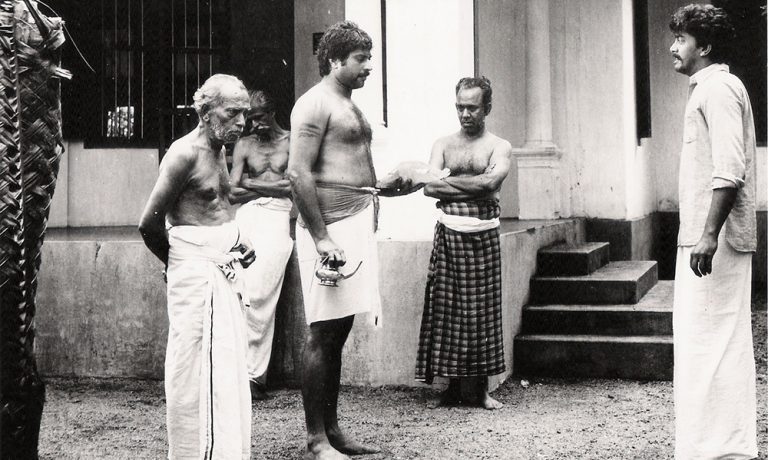Festivals: Venice, Pesaro, Karlovy Vary, La Rochelle, Nantes, Amiens, Riga, Munich, Bribourge, Ljubljana, Helsinki, London, Washington DC, New York, San Francisco, Toronto, Hawaii and Alexandria among others.
Awards: International Film Critics Prize(FIPRESCI) for the Best film, Karlovy Vary Film Festival.
National Awards: for Best Director, Best Screenplay, and Best Audiography.
Kerala State Award for Best Director.
Synopsis
 Ajayan’s own account of himself, we come to learn that he was born with a stigma. As an unwanted child, he was abandoned by his mother in the labour room of a hospital.
Ajayan’s own account of himself, we come to learn that he was born with a stigma. As an unwanted child, he was abandoned by his mother in the labour room of a hospital.From The doctor of the hospital takes the infant with him when he retires from service and brings him up like his own son, lavishing love and affection on him.
Even as a schoolboy, Ajayan finds himself a misfit among others—mainly because of his talents. His sharp wit and exceptional brilliance prove to be his undoing. Society, he discovers, is essentially averse to the out-of- the-ordinary; it is more at home with the average. In a way, the very essentials of day-to-day existence depend much on conformity and compliance. To Ajayan, whether in the class room, playground or the’ world outside, the message keeps coming back.
The indefinability of his relationship with others—whether in the family or the society he moves in— the absence of a feeling of belonging, and a gnawing sense of loss, drive Ajayan to despondency and a state of neurosis.
 As the first story draws to a close, Ajayan is ridden with guilt and remorse about his forbidden feelings for his foster-brother’s young bride. He wants to run away from it all—but cannot.
As the first story draws to a close, Ajayan is ridden with guilt and remorse about his forbidden feelings for his foster-brother’s young bride. He wants to run away from it all—but cannot.
Ajayan’s distraught mind wanders between the realms of memory and imagination. Events and impressions of the past are reconstructed in justification of an impossible relationship. The real grows into the fantastic and the dividing line evaporates into thin dir.
The Nalini of Ajayan’s second story (a look-alike of Suma, his brother’s attractive wife) could be seen as a figment of his imagination but, then again, it needn’t. The indivisibility of the real and the imaginary slowly intensifies, pushing Ajayan to the brink of crisis.
Director’s Statement
Anantaram, at one level is a film about story telling or rather about the very process of artistic creation.
Ajayan the protagonist is on the verge of a nervous break-down. Through the stories that he narrates, he is trying to reveal and justify how he reached this stage. No rational explanation can in fact give a complete and final answer. He is drawing up on the experiences from his life basically from two stand-points – that of an introvert and an extrovert, the two positions we all keep shifting from time to time. The first story is about Ajayan the extrovert. A mediocre world around him keeps stifling him as he is too brilliant for it to contain. He withdraws and gets pushed to seclusion and mental strain. The second story is about Ajayan the introvert. Having been relegated to neglect and loneliness, he grows up in the midst of three old servants who are alternatively caring and scaring the little boy. His sensitivity and imagination take him to a world of active fantasy and an inability to grasp reality. Lies become real and the real turns lies for him.
Each story picks and chooses from those experiences from his life that go to prove its theme. The stories do not contradict themselves, instead they complement each other. The stories jell together because there is a certain built-in ambivalence in his life. He is an abandoned child in a hospital who is adopted by the doctor as his own. There is an imagined father-son relationship but he can call him only uncle. The doctor’s own son who is hard-working and an achiever is not his brother but is brother-like. His young and beautiful wife is like his sister-in-law, but more like or is his former love, Nalini. The duality of perceptions leads to difficult predicaments.
Filmmakers and Critics Say
(Mrinal Sen)
(Richard Greenbaum in FILMS IN REVIEW)
(A.V.Ashok in his book, ‘Hours of Enchantment’)
Credits
- Story, Script & Direction : Adoor Gopalakrishnan
- Producer : Ravi
- Photography : Ravi Varma
- Audiography : Devadas, Krishnanunni & Harikumar
- Editing : M.Mani
- Music : M.B. Srinivasan
- Art Direction : Sivan
- Associate Director : Meera
- Chief Assistant : M.P.Sukumarannait
- Production Controller : Rajasekharan Nair
- Production Company : General Pictures
- Duration : 125 mts; Colour Eastman Year of Prodn.1987
- Language : Malayalam Country India
Cast
- Ashokan(Ajayan Sudheesh (Ajayan-boy),
- Sooraj (Ajayan-child),
- Mammootty (Doctor Balu, Doctor-Uncle’s son)
- Shobhanz (Suma,Balu’s wife & Nalini),
- N.B. Thampi (Doctor – Uncle),
- B.K. Nair (Compounder),
- Vempayam(Cook),
- Bahadur(Driver),
- Chandran Nair (Teacher),
- C.R.Ajayakumar (Ajayan’s hostel mate),
- K.P.S. Kurup (Headmaster),
- John Samuel (Drillmaster),
- Krishnankutty Nair(Patient),
- Srinivasa Sharma(Musician),
- P.Ganga(Imposter),
- Somasekharan Nair(Tea-shop proprietor),
- Shanmukham Pillai(Teamaker),
- Adoor Pankajam (Lakshmi Amma),
- Unnipillai(Teacher),
- Kuku Parameswaran (Nurse),
- Sindhu(Latha),
- Geethi Prasad (Dancer),
- Lolita(Lakshmi Amma’s daughter),
- Annakutty(Neighbour),
- Mumtaz (Neighbour),
- Aliyar(Professor),
- Ravi Attingal (Professor),
- Azeez (Grambling-den owner),
- Binu & Issac Abraham(Bullies),
- Kannan (Ajayan-infant),
- Kaviyoor Ponnamma (Ashram Mother)etc….
More Stills: |
|||||
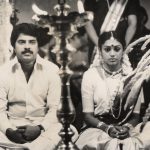 |
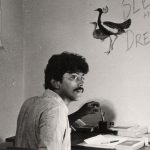 |
 |
 |
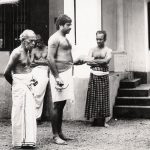 |
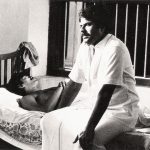 |
Working Stills: |
|
 |
|

